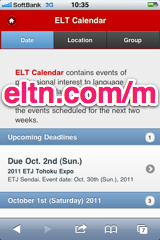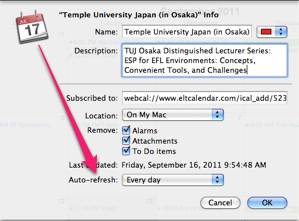Nara JALT:
Melodic Methodologies: a movement to motivate young learners
Date: Sunday, August 23rd, 2015 Time: 10:00 AM - 4:00 PM
Speaker: Greg Crawford, Bevan Joseph Bulmer (BJ), Scott Crowe, Nanae Yukioka
Description:
Beat the heat and feel the beat! Anyone involved in teaching Young Learners should make every effort possible to attend Nara JALT's mammoth August event: Melodic Methodologies. This promises to be a memorable and motivating event with three marvelous presentations.
Please be sure to bring your lunch
Presentation 1: Using Songs as Effective Tools in the YL Classroom
Greg Crawford and Bevan Joseph Bulmer (BJ)
Not getting the most out of using songs in your Young Learner classroom? Take home some great tips and techniques to help you squeeze every last drop of language learning juice out of songs in this highly energetic and exciting presentation. Songs are incredibly powerful and effective learning tools in the Young Learner classroom. Unfortunately, they are also often underutilized. Let Greg and BJ show you how to get the absolute most out of songs in your classroom in this fun and energetic presentation from Fun Kids English. Take home the tools and practical applications to maximize the fun and learning potential of songs in your Young Learner classroom! Your students will thank you with big smiles, great participation and improved language learning.
Presenters' Bios: Greg Crawford has been teaching Young Learners of English for 15 years and is a creative director of Fun Kids English. He is a co-creator of Fun Kids English's Fun Kids Songs CD series and is also the author of Fun Phonics Readers, a series of graded children's readers from Fun Kids English. Greg is a regular presenter on the English language teaching circuit in Japan and is the owner and principal of Aire English School based in Wakayama Prefecture, Japan. Greg is particularly interested in Young Learners, music for learning, using songs in the classroom, reading for children and phonics.
BJ Bulmer has been teaching Young Learners of English for 18 years and is a creative director of Fun Kids English. He is the owner and principal of Koala English School, based in Wakayama Prefecture in Southern Japan. BJ is a co-creator of Fun Kids English's Fun Kids Songs CD series and is a regular presenter on the English language teaching circuit in Japan. He has been playing music both as a live and studio musician for the past 25 years. BJ's interests are Young Learners, songwriting, creating captivating music and reading for children.
Presentation 2: Introducing Magic House Books!
Scott Crowe
Why are so many parents so excited about Magic House Books? Magic House Books are designed to get kids speaking more naturally. Magic House Books are designed to get kids emotionally involved in the imaginative world of the story and help the characters to solve problems using English. Here are some examples of Magic House Books vs regular textbooks.
- There's a ball under the table: This grammar is one of the most useful grammar structures in the English language yet when we teach it to children most textbooks use a ball and a table. Where is the ball? The ball is under the table. The ball is on the table. This is clear and easy to understand but it is not emotionally engaging for children so the teacher will have to make the children repeat it. In Magic House Books, there is a character who is trying to go to bed but there are bugs hiding in the room. So the children must warn the character. Watch out! There's a spider under the bed! Not only do kids use the English naturally, they love to speak and help out the characters.
- TPR: TPR is Total Physical Response, which is a way to teach English by having kids do the actions that a teacher says such as jump, walk, run and after a while the kids learn the language. This is very good for children. What Magic House Books has done is take those same actions and added an emotional value to doing those actions. WHY are they running? They are running because all the bugs jumped in the window. As well, all of the action words that kids need to learn are built into the storyline so the kids not only learn the words but they are able to act out the stories in a fun way.
- Emotional Positioning: This technique was created by the author of the books. This technique is a very special technique created to help children learn language in a very natural and enjoyable way. It is also used to teach language that is extremely useful but difficult to teach with traditional methods. For example, here are a few of the most used words in children's books go, come, away, here, this, is and there. In regular books, some of these words may not be taught until the second or third year but in Magic House Books they are taught right away in an enjoyable way that kids love. Go away is used to tell the mosquito to leave and Come here is used to call the cute bugs like the ladybug to the children.
We are so excited to use these books to help your children enjoy English and speak naturally!
Presentation 3: 1+1>2: The Power of Team Teaching
Nanae Yukioka
Have you ever experienced team-teaching? Have you ever had difficulty making a lesson with someone who has a different perspective on teaching styles and methodologies or someone who has other teaching responsibilities? Have you ever made students confused by team-teaching with a blurred focus? Team-teaching is not easy, but team-teaching itself can show students an authentic model of communication in our real life. The presenter will explore the essence of inter-teachers communication in team-teaching, ways to form the foundation of communication skill through a foreign language, and also share some classroom practice of activating ?mind?, ?body? and ?heart? through classroom interaction using Hi, friends! , an English textbook published by MEXT.
Presenter Bio: Yukioka is a J-SHINE certified teacher trainer. J-SHINE is an NPO whose aim is to help promote the teaching of English in Japanese primary education by Japanese instructors. It offers training and seminars to those who are interested in teaching English at elementary school. She is currently teaching at a public elementary school in Hirakata and at home. Her 10-year experience of teaching English to young learners convinces her that teaching English is not only to give children an opportunity to learn a foreign language but to foster their intercultural communicative competence.
Organization: Nara Chapter of the Japan Association for Language Teaching (Nara JALT)
Cost: JALT Members: free
Non-members: 1000 yen
Venue: Yamato Conference Hall (map)
Location: Nara City, Nara Prefecture, Japan
![]() Add this to iCal
Add this to iCal
![]() (Need help?)
(Need help?)
![]() Add to Outlook
Add to Outlook
![]() (Need help?)
(Need help?)
Contact Nara JALT
Website: http://jaltnara.wordpress.com/
Email QR Code:








